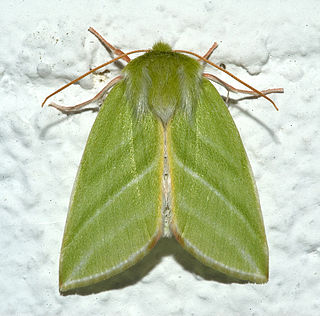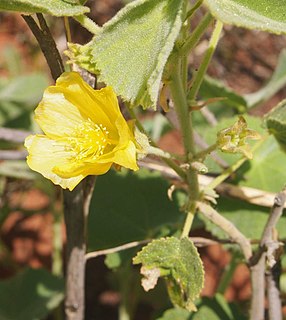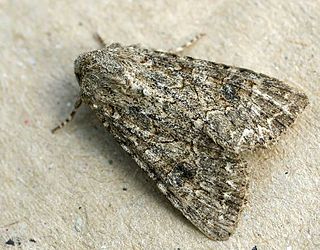| Earias perhuegeli | |
|---|---|
 | |
| Scientific classification | |
| Kingdom: | |
| Phylum: | |
| Subphylum: | |
| Class: | |
| Order: | |
| Family: | |
| Genus: | |
| Species: | E. perhuegeli |
| Binomial name | |
| Earias perhuegeli Holloway, 1977 | |
| Synonyms | |
| |
The rough bollworm (Earias perhuegeli) is a moth of the family Nolidae. It is found in the northern two-thirds of Australia and several islands in the South Pacific.

Moths comprise a group of insects related to butterflies, belonging to the order Lepidoptera. Most lepidopterans are moths, and there are thought to be approximately 160,000 species of moth, many of which have yet to be described. Most species of moth are nocturnal, but there are also crepuscular and diurnal species.

Nolidae is a family of moths with about 1,400 described species worldwide. They are mostly small with dull coloration, the main distinguishing feature being a silk cocoon with a vertical exit slit. The group is sometimes known as tuft moths after the tufts of raised scales on the forewings of two subfamilies, Nolinae and Collomeninae. The larvae also tend to have muted colors and tufts of short hairs.

Australia, officially the Commonwealth of Australia, is a sovereign country comprising the mainland of the Australian continent, the island of Tasmania and numerous smaller islands. It is the largest country in Oceania and the world's sixth-largest country by total area. The neighbouring countries are Papua New Guinea, Indonesia and East Timor to the north; the Solomon Islands and Vanuatu to the north-east; and New Zealand to the south-east. The population of 25 million is highly urbanised and heavily concentrated on the eastern seaboard. Australia's capital is Canberra, and its largest city is Sydney. The country's other major metropolitan areas are Melbourne, Brisbane, Perth and Adelaide.
The wingspan is about 20 mm. [1] The larvae feed on Gossypium australe , Gossypium populifolium , Abutilon otocarpum , Abelmoschus ficulneus , Hibiscus trionum , Hibiscus panduriformis , Alyogyne hakeifolia and Adansonia gregorii , and are considered a pest of Gossypium hirsutum .

The wingspan of a bird or an airplane is the distance from one wingtip to the other wingtip. For example, the Boeing 777-200 has a wingspan of 60.93 metres, and a wandering albatross caught in 1965 had a wingspan of 3.63 metres, the official record for a living bird. The term wingspan, more technically extent, is also used for other winged animals such as pterosaurs, bats, insects, etc., and other fixed-wing aircraft such as ornithopters. In humans, the term wingspan also refers to the arm span, which is distance between the length from one end of an individual's arms to the other when raised parallel to the ground at shoulder height at a 90º angle. Former professional basketball player Manute Bol stands at 7 ft 7 in (2.31 m) and owns one of the largest wingspans at 8 ft 6 in (2.59 m).

Gossypium australe is an endemic woody shrub, related to cotton, found in north western Australia. Preferring sandy soils near watercourses, it grows to about two or three feet tall. The leaves are grey and hairy, oval to elliptic, 3 inches (8 cm) long and soft to the touch. Flowers are around 1–2 inches (3–5 cm) long and present a pale pink mauve 'rose' with a deeper shade at the centre. Fruit are hairy, spherical and contain a bristly seed one-sixth inch (0.4 cm) long.

Abutilon otocarpum, the desert lantern, is a small shrub of the Malvaceae family found in most parts of Australia.











